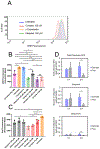Solubilized ubiquinol for preserving corneal function
- PMID: 34087583
- PMCID: PMC8325625
- DOI: 10.1016/j.biomaterials.2021.120842
Solubilized ubiquinol for preserving corneal function
Abstract
Defective cellular metabolism, impaired mitochondrial function, and increased cell death are major problems that adversely affect donor tissues during hypothermic preservation prior to transplantation. These problems are thought to arise from accumulated reactive oxygen species (ROS) inside cells. Oxidative stress acting on the cells of organs and tissues preserved in hypothermic conditions before surgery, as is the case for cornea transplantation, is thought to be a major reason behind cell death prior to surgery and decreased graft survival after transplantation. We have recently discovered that ubiquinol - the reduced and active form of coenzyme Q10 and a powerful antioxidant - significantly enhances mitochondrial function and reduces apoptosis in human donor corneal endothelial cells. However, ubiquinol is highly lipophilic, underscoring the need for an aqueous-based formulation of this molecule. Herein, we report a highly dispersible and stable formulation comprising a complex of ubiquinol and gamma cyclodextrin (γ-CD) for use in aqueous-phase ophthalmic products. Docking studies showed that γ-CD has the strongest binding affinity with ubiquinol compared to α- or β-CD. Complexed ubiquinol showed significantly higher stability compared to free ubiquinol in different aqueous ophthalmic products including Optisol-GS® corneal storage medium, balanced salt solution for intraocular irrigation, and topical Refresh® artificial tear eye drops. Greater ROS scavenging activity was noted in a cell model with high basal metabolism and ROS generation (A549) and in HCEC-B4G12 human corneal endothelial cells after treatment with ubiquinol/γ-CD compared to free ubiquinol. Furthermore, complexed ubiquinol was more effective at lowering ROS, and at far lower concentrations, compared to free ubiquinol. Complexed ubiquinol inhibited lipid peroxidation and protected HCEC-B4G12 cells against erastin-induced ferroptosis. No evidence of cellular toxicity was detected in HCEC-B4G12 cells after treatment with complexed ubiquinol. Using a vertical diffusion system, a topically applied inclusion complex of γ-CD and a lipophilic dye (coumarin-6) demonstrated transcorneal penetrance in porcine corneas and the capacity for the γ-CD vehicle to deliver drug to the corneal endothelium. Using the same model, topically applied ubiquinol/γ-CD complex penetrated the entire thickness of human donor corneas with markedly greater ubiquinol retention in the endothelium compared to free ubiquinol. Lastly, the penetrance of ubiquinol/γ-CD complex was assayed using human donor corneas preserved for 7 days in Optisol-GS® per standard industry practices, and demonstrated higher amounts of ubiquinol retained in the corneal endothelium compared to free ubiquinol. In summary, ubiquinol complexed with γ-CD is a highly stable composition that can be incorporated into a variety of aqueous-phase products for ophthalmic use including donor corneal storage media and topical eye drops to scavenge ROS and protect corneal endothelial cells against oxidative damage.
Keywords: Coenzyme Q10; Corneal endothelium; Cyclodextrin; Eye banking; Ferroptosis; Inclusion complex; Keratoplasty; Molecular docking; Reactive oxygen species; Ubiquinol.
Copyright © 2021 Elsevier Ltd. All rights reserved.
Conflict of interest statement
Conflicts of Interest: No relevant financial interests to disclose.
Declaration of interests
The authors declare that they have no known competing financial interests or personal relationships that could have appeared to influence the work reported in this paper.
Figures





References
-
- Awad EM, Khan SY, Sokolikova B, Brunner PM, Olcaydu D, Wojta J et al. Cold induces reactive oxygen species production and activation of the NF-kappa B response in endothelial cells and inflammation in vivo. Journal of thrombosis and haemostasis : JTH. 2013;11(9):1716–26. doi:10.11n/jth.12357. - DOI - PubMed
Publication types
MeSH terms
Substances
Grants and funding
LinkOut - more resources
Full Text Sources
Other Literature Sources

